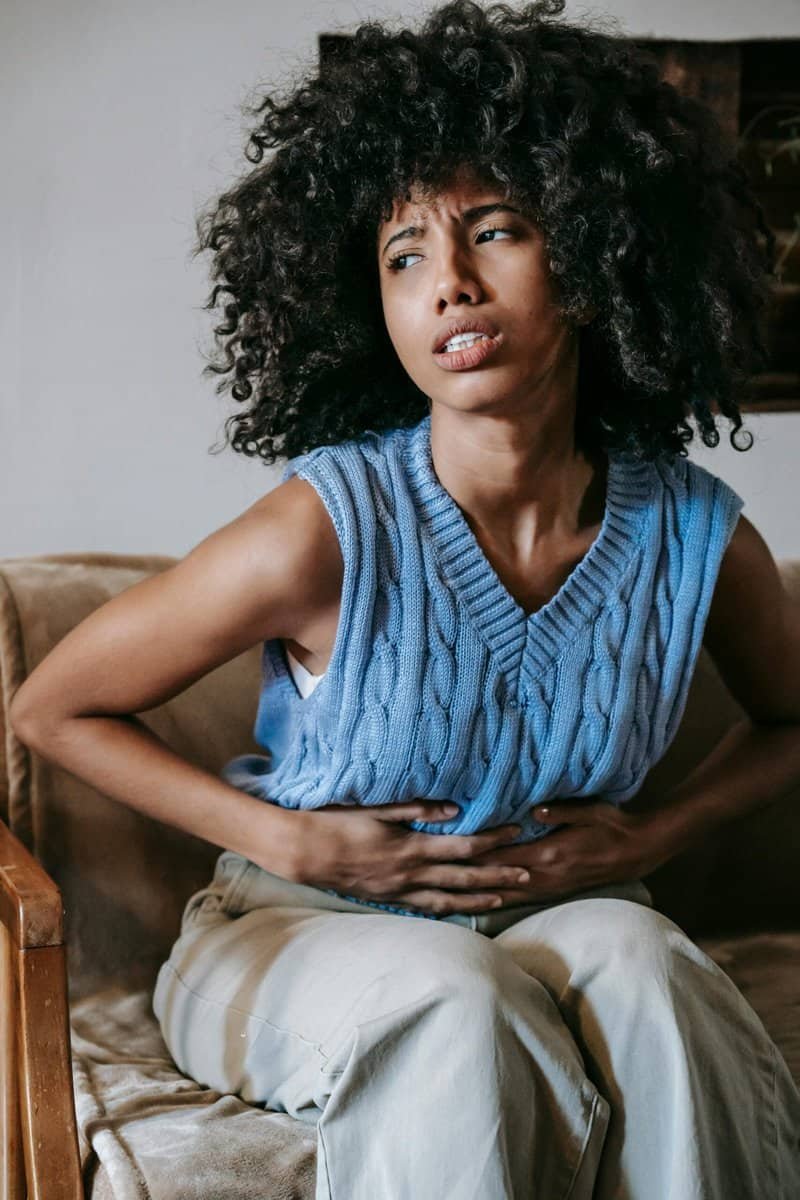How To Get Rid Of Female Abdominal Pain?

Contents ⇓
-
What is Abdominal pain
-
Overview of common symptoms
-
Diagnosis and Treatments
-
Home Remedies
-
Prevention
1. What is Abdominal Pain?
Female abdominal pain refers to pain or pain felt everywhere between the
chest and groin. It can range from moderate to severe and can occur or
develop gradually. Causes vary from indigestion and gas to serious
conditions like appendicitis or gallstones. Accurate analysis is vital for
suitable treatment.
2. Overview of Common Symptoms:
Menstrual Cramps:
Many ladies revel in abdominal aches or cramping during menstruation,
called dysmenorrhea. This ache usually happens in the lower stomach
and can be followed through other menstrual symptoms like bloating
and mood modifications.
Pelvic Pain:
Pelvic pain in females often stems from gynecological issues like endometrial
disease, ovarian fibroids, or pelvic infection. However, digestive or urinary causes,
such as irritable bowel syndrome or painful bladder, can also cause discomfort.
Noticing the source is vital, as interrelated symptoms usually require specific,
focused treatments for relief.
Painful Intercourse:
Painful intercourse in females can be related to vaginal dryness, fibrous tissue
from surgeries, or pelvic nerve irritation. Conditions like vaginal muscle spasms,
where muscles involuntarily tighten, may also add. Managing underlying issues
through therapies like physical therapy, wetting, or counseling can be important
for restoring comfort and improving sexual well-being.
Irregular Menstrual Cycles:
Female abdominal pain or soreness followed through irregular menstrual
cycles, consisting of neglected durations or unusually heavy or extended
bleeding, may indicate hormonal imbalances, polycystic ovary syndrome
(PCOS), or other reproductive fitness problems.
Urinary Symptoms:
Abdominal aches in ladies may also be associated with urinary signs including
frequent urination, urgency, burning sensation during urination, or blood inside
the urine, indicating urinary tract infections (UTIs), kidney
stones, or other urinary tract issues.
Digestive Issues:
Abdominal aches in ladies may be associated with digestive troubles, including
indigestion, gasoline, bloating, constipation, or loose tools. Nutritional factors,
hormonal modifications, or underlying gastrointestinal situations may trigger
these symptoms.
Painful Bowel Movements:
Pain or soreness all through bowel moves can arise because of
situations affecting the intestines or rectum, such as irritable
bowel syndrome (IBS), inflammatory bowel ailment (IBD), piles,
or anal fissures.
Pregnancy-Related Symptoms:
Abdominal pain in pregnant women may also indicate various being
pregnant-related complications inclusive of ectopic pregnancy, miscarriage,
preterm labour, or placental troubles. It’s crucial for pregnant ladies to
directly record any abdominal pain to their healthcare company.
3. Diagnosis and Treatments

Female Abdominal Pain
- Ovarian Cysts
- Endometriosis
- Urinary Tract Infections
- Irritable Bowl Syndrome(IBS)
a. Ovarian Cysts:
Diagnosis of ovarian cysts usually entails a pelvic examination, ultrasound imaging,
and occasionally blood tests to evaluate hormone stages. Treatment varies based
totally at the cyst’s length, type, and signs. Small, asymptomatic cysts may not
necessitate remedy and might instead be monitored periodically. However, if a
cyst is big, causing signs, or appears suspicious, similarly evaluation and treatment
can be necessary. Options may additionally encompass medicinal drugs to modify
the menstrual cycle, surgery to cast off the cyst (cystectomy), or, in rare cases,
removal of 1 or both ovaries (oophorectomy).
b. Endometriosis:
The diagnosis of endometriosis generally requires a
comprehensive approach, including the following-
Medical History:
The health care provider asks the patient about symptoms, menstrual
history, pelvic pain, and related issues such as infertility.
Pelvic exam:
A pelvic exam can check for abnormalities such as tender nodules or
masses in the pelvic area, although not all cases of endometriosis
receive physical findings during a pelvic exam.
Imaging tests:
Although imaging tests such as ultrasound or MRI can help diagnose
large endometriotic cysts (endometrioma) or deep infiltrating endometriosis
in some cases, these tests are not always definitive for diagnosing status.
Laparoscopy:
Histology:
c.Urinary Tract Infections:
Causes:
A UTI occurs when food-borne bacteria, usually Escherichia coli (E. coli), enter
the stool and multiply in the bladder Factors such as sexual activity, insufficient
urination, urinary retention in and mutations for risk of UTI in woman.
Symptoms:
The most common symptoms of a UTI in women are:
Pain or burning when urinating Constant desire to urinate
small tubes cloudy or strongly smelling water pelvic pain or
discomfort Blood in the urine, Fever or chills (symptoms of most diseases) .
Diagnosis:
Healthcare professionals diagnose a UTI based on symptoms, medical history,
and urine tests. Stool tests and stools are helpful in identifying the virus and
determining the appropriate course of treatment.
Treatment:
UTIs are usually treated with antibiotics to prevent infection. The choice of
antibiotics depends on the type of organisms causing the infection and
their susceptibility to antibiotics. Even if symptoms improve, it is important
to complete all courses of antibiotics as indicated, to prevent further and
antibiotic resistance.
Prevention:
Prevention of UTIs in women includes:
To encourage daily urination and antibacterial and stay hydrate
- Shots before and after sex
- Wiping back and forth after using the toilet
- Avoid irritating feminine products or urinals
- Good practice in sexual hygiene
- Drinking cranberries or drinking cranberry juice
4. Complications:
If left untreated, a UTI can lead to serious complications such as
kidney infection (pyelonephritis), recurrent UTI, sepsis (life-
threatening due to spread of the infection), and long-term
kidney damage grade.
5. Other tests include:
Imaging tests such as MRI, ultrasound, and X-rays are used to identify
abdominal organs, tissues and other advanced structures.
These tests can help diagnose nausea, vomiting, loose tools
and inflammation.
1. Colonoscopy (to look at the colon and bowel)
2. Endoscopy (to detect inflammation and abnormalities in the digestive tract and stomach)
3. Upper GI (a basic x-ray test that uses a contrast agent to check for
abnormalities such as growths, ulcers, inflammation, blockages, etc. in the stomach lining.
4. Blood, urine, and stool samples may also include to be collected to
look for evidence of bacterial, viral and parasitic infections.
6. Home Remedies For Abdominal Pain:
If our abnormal medical condition is not that much severe, there are a
number of home remedies that may provide a long lasting relief here
includes some:
- Drinking water
- Baking soda
- Ginger
- Chamomile tea
- Heating pad
- Warm bath
- Apple cider vinegar
How can i prevent abdominal pain?
-Eating a healthy diet
-Drinking lots of water
-Exercise regularly
-Make a habit of taking Smaller meals
https://absoluteinformation.com/overcoming-challenges-in-achieving-pregnancy/

